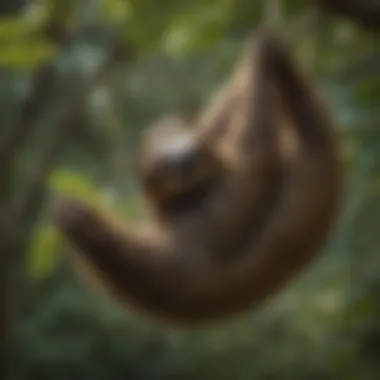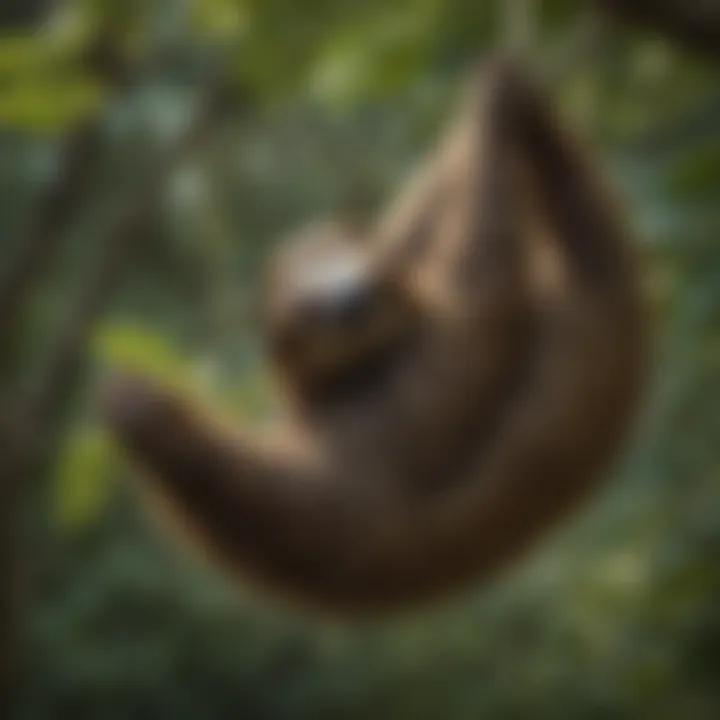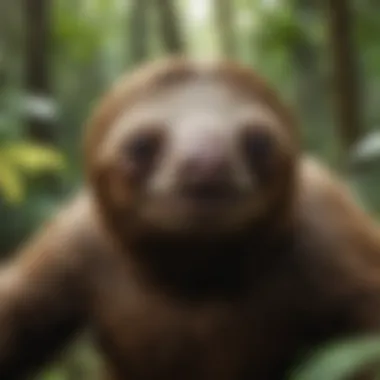Exploring Sloths: Adaptations, Ecology, and Conservation


Intro
Sloths have often been regarded as symbols of lethargy, but there is much more to these peculiar creatures than meets the eye. As inhabitants of the tropical forests of Central and South America, they have developed unique adaptations that enable them to thrive in their ecological niches. This article seeks to illuminate the evolutionary adaptations, ecological roles, and conservation needs of sloths, emphasizing their significance in maintaining healthy ecosystems.
Research Overview
Summary of Key Findings
From their slow metabolism to their distinct diets, sloths display an array of fascinating features that ensure their survival in the wild. For instance, the broad, clawed limbs of the three-toed sloth allow it to hang effortlessly from tree branches, while its specialized diet consists primarily of leaves that are low in nutritional content.
Recent studies highlight the intricate symbiotic relationships sloths maintain with various species. Algae, for example, grows within their fur, providing camouflage and additional nutrients. Understanding these relationships sheds light on their adaptations and overall health within their ecosystem.
Importance of the Research
This research is crucial not only for academic purposes but also for conservation efforts. As sloths face increasing threats from habitat destruction, deforestation, and climate change, understanding their biology and ecological significance allows for informed protection strategies. This insight also adds depth to the dialogue on broader conservation issues, underscoring the interconnectedness of all species.
Methodology
Study Design
The research utilized a combination of observational studies and quantitative analysis. Field studies were conducted in various habitats across the tropical regions to document the behaviors and interactions of sloths in different environments.
Data Collection Techniques
Data was collected through a mix of direct observation and remote sensing technology. Researchers employed camera traps and GPS tracking to monitor sloth movements and gather data on their feeding habits, social interactions, and habitat use.
"By understanding the needs and habits of sloths, we can better advocate for their protection and the preservation of their habitats."
Prologue to Sloths
Understanding sloths is crucial in the study of biodiversity and conservation. As unique creatures, they offer insights into evolutionary adaptations and ecological balance. This section will detail what makes sloths distinctive within their habitat and their evolutionary journey. This knowledge not only adds to our appreciation of wildlife but also informs conservation strategies aimed at preserving these vulnerable species.
Defining Sloths within the Animal Kingdom
Sloths belong to the order Pilosa, which also includes anteaters. Within this order, sloths are classified into two main families: Megalonychidae, which includes two-toed sloths, and Bradypodidae, consisting of three-toed sloths. These small, slow-moving mammals are primarily found in the tropical rainforests of Central and South America.
Their defining characteristics include long limbs, a specialized diet, and a slow metabolic rate. Sloths have evolved to consume a diet largely consisting of leaves, which is not energy-dense. The adaptations in their digestive system help them achieve maximum nutrient absorption. These traits place sloths as a unique grouping in the animal kingdom. Understanding these classifications aids in conservation efforts and habitat management.
A Brief Evolutionary History
Sloths have a rich evolutionary history that dates back millions of years. Their ancestors were much larger, with giant species such as Megatherium roaming the earth during the Pleistocene epoch. Over time, climatic changes and human activity led to their decline.
Modern sloths diverged from their ancient relatives and adapted to life in trees, through developing specialized limbs and claws. These adaptations allowed them to navigate their arboreal environment efficiently. The evolutionary journey of sloths demonstrates a fascinating case of adaptation and survival amidst changing ecosystems. By studying their evolution, researchers gain valuable insights into the ecological dynamics of past and present environments.
Sloth Species Overview
Understanding the various species of sloths is crucial in comprehending their ecological roles and current conservation status. The two most recognized types, Two-Toed Sloths and Three-Toed Sloths, offer insights into the adaptations and behaviors unique to their respective species. Each species has adapted to its environment in distinct ways, contributing differently to the ecosystems they inhabit. A closer examination provides clarity on how each species plays a role in their habitat while illuminating the challenges they face.
Two-Toed Sloths
Two-Toed Sloths belong primarily to the genera Choloepus. They are characterized by their reduced number of toes, specifically possessing two elongated digits on their forelimbs. This structural adaptation allows for a powerful grip, which is essential for their arboreal lifestyle. The limbs are strong and muscular, designed for hanging and moving through trees with ease.
Two-Toed Sloths exhibit a slower metabolism compared to their three-toed counterparts. This metabolic adaptation aids them in surviving on a diet primarily composed of leaves, which are low in nutritional value. Their digestive system is quite unique, taking up to a month to process food in their complex stomachs.
Interactions with their environment highlight the two-toed sloths' profound social behavior. They are mostly solitary, but they have been observed engaging in activities such as grooming and vocal communications when in proximity to others. This species is less prone to limb paralysis than three-toed sloths, likely due to their greater overall muscle mass.
Additional notable facts:
- Adult Two-Toed Sloths can weigh up to 16 kilograms.
- Their coloration is often influenced by the algae that grow on their fur, aiding in camouflage within the forest canopy.
Three-Toed Sloths


Three-Toed Sloths, classified under the genus Bradypus, possess three long, curved toes on each foot. This anatomical feature supports their slow movement, which is a significant part of their survival strategy. They move with a deliberate pace to minimize energy expenditure, an essential adaptation given their nutrient-poor diet of leaves.
The three-toed species are generally smaller than Two-Toed Sloths, with adults averaging about 6 to 8 kilograms. Their fur not only provides insulation but also serves as a habitat for a variety of organisms, such as algae and insects. The relationship with these organisms is symbiotic; the algae can provide camouflage while also influencing the sloth's body temperature.
Behaviorally, Three-Toed Sloths are known to be more social compared to their two-toed relatives, often sharing tree branches and engaging in social grooming. Reproductive behavior also varies, with females displaying significant agency in mate selection. Their gestation period lasts around six months.
Some distinguishing points about Three-Toed Sloths:
- They have a unique form of locomotion, utilizing a mix of hanging and sideways movements.
- Their eyes are adapted for seeing in low light, aiding their nocturnal activities.
Anatomical and Physiological Features
The anatomical and physiological features of sloths are critical to understanding their survival strategies and niches in their ecosystems. These characteristics reflect centuries of adaptation to their environments, highlighting their unique place in the animal kingdom. Sloths have evolved particular traits that contribute to their slow-paced lifestyle and resource efficiency. Understanding these features offers insight into their ecological roles and informs ongoing conservation efforts.
Unique Limb Structure
Sloths exhibit a remarkable limb structure that is vital for their arboreal lifestyle. Their limbs are long and curved, equipped with three or two toes that end in sharp claws. These adaptations enable sloths to grip tree branches securely. The specialized limb structure minimizes the energy required to hang on to their perches, which is crucial given their low metabolic rates.
This unique morphology serves several functions:
- Energy Efficiency: The design helps conserve energy by allowing sloths to hang motionless for long periods.
- Predator Avoidance: Staying still in the foliage reduces the likelihood of attracting predators.
- Feeding Mechanism: The claws aid in foraging for leaves, their primary food source.
Digestive Adaptations
Sloths possess a highly specialized digestive system. Their slow metabolism is optimized for breaking down tough, fibrous plant material. They have a multi-chambered stomach, acting similarly to ruminants, which allows for prolonged digestion. The fermentation process in their guts can take up to a month, resulting in highly energy-efficient nutrient absorption.
Important aspects of their digestive adaptations include:
- Symbiotic Relationships: Sloths rely on a complex microbiome of bacteria in their intestines to break down cellulose.
- Low Nutritional Intake: Their diet primarily consists of leaves, which are low in nutritional value, making efficient digestion essential for survival.
- Energy Recycling: By digesting slowly, sloths can reabsorb more nutrients from their food, ensuring adequate energy supply despite limited intake.
Metabolic Rate and Energy Conservation
Sloths are known for their extremely low metabolic rates, which play a substantial role in their survival strategy. Their bodies function with minimal energy expenditure, a necessity in the tropical habitats where food sources are sparse and sporadic.
Key factors about their metabolic adaptations are:
- Temperature Regulation: Sloths have a lower body temperature than many mammals, which conserves energy but also makes them vulnerable to extreme weather changes.
- Feeding Frequency: They typically eat leaves only a few times a week, complementing their low-energy diet by minimizing foraging activities.
- Reduced Activity Levels: Sloths generally sleep for long periods and move very slowly, reducing the energy needed for activity.
"Sloths symbolize the efficiency of evolution; their adaptations may appear slow, but they illustrate a profound mastery of resource management."
Behavioral Characteristics
Understanding the behavioral characteristics of sloths is essential for grasping their adaptations and roles within ecosystems. Their behavior reflects their evolutionary journey and the specific ecological niches they occupy. Sloths are known for their slow movement and deliberate actions. These traits, while seemingly disadvantageous, serve important functions in their survival, promoting energy conservation, enhancing camouflage, and facilitating a specialized lifestyle that addresses their nutritional needs effectively.
Activity Patterns
Sloths exhibit a differentiated pattern of activity that contributes to their unique ecology. Most sloths are primarily diurnal, although some species may be active at night. The daily rhythm is largely dictated by their feeding habits and environmental factors.
- Feeding Habits: Sloths spend a substantial portion of their lives foraging for food, often engaged in a routine of eating leaves and fruits. Their diet is low in energy, making it critical for them to maximize their foraging efficiency. The consumption of leaves with few nutrients necessitates frequent resting periods to conserve energy.
- Slow Metabolism: The metabolic rate of sloths is notably low. This adaptation permits a slow-paced lifestyle, which in turn reduces energy expenditure. Their bodies have adapted to prioritize energy conservation; this means sloths can go for extended periods without eating if necessary.
"The slow lifestyle of sloths has evolved as a response to the challenges presented by their habitat."
- Resting and Sleeping Patterns: Sloths can sleep for up to 20 hours each day. Resting not only conserves energy but also reduces exposure to predators and environmental stressors. They are most vulnerable during active foraging sessions, so their tendency to find high branches can provide a natural refuge.
Social Interactions and Reproductive Behavior
Sloths display a range of social interactions, although they are generally solitary creatures. Social behavior might not be as pronounced as seen in other mammals, yet mating and parental care exhibit specific patterns worthy of note.
- Mating Rituals: In their reproductive behavior, sloths have a rather unique courtship process. Males often attract females through vocalizations, which can be heard over considerable distances. Their breeding season, depending on the species, can take place at different times of the year, though many sloths do not adhere strictly to seasonal patterns.
- Parental Care: After a gestation period that lasts between 5 to 11 months, depending on the species, a single offspring is born. Female sloths display considerable maternal instincts, caring for their young for several months. The infant clings to the mother’s fur, where it receives warmth and nourishment. This close physical connection offers protection from predators and increases the young’s survival chances.
- Territorial Behavior: Although there is minimal territorial aggression among sloths, individuals can be seen marking their trees and surroundings. This serves as a way of communication about their presence and may assist in mating recognition.
Sloth behavior, from their slow movements to selective social interactions, reflects a finely tuned evolutionary response to their environment. As unique dwellers of the treetops, their behavioral adaptations foster an intriguing interplay with ecological systems.
Habitat and Distribution


Understanding the habitat and distribution of sloths is paramount for comprehending their ecological roles. Their dependence on specific environmental conditions shapes their lifestyle and survival strategies. Different species exhibit varied habitat preferences, which directly relate to their behavioral traits and evolutionary adaptations. Moreover, habitat destruction poses a significant threat to sloth populations, making conservation efforts essential to ensure their persistence in the wild.
Geographic Range
Sloths are native to the tropical rainforests of Central and South America. Their geographic range spans from southern Mexico, through Central America, down to parts of Argentina. This limited distribution highlights their specialized ecological niche. The precise location and abundance of sloth species often correlate with specific rainforest types, such as those rich in foliage and biodiversity. For instance, the brown-throated sloth is primarily found in wet lowland forests, where it can find ample food sources and shelter.
- Sloths are primarily found in tropical rainforests, an ecosystem that is crucial for their survival.
Preferred Habitats
Sloths thrive in diverse habitats, but they show a strong preference for areas with dense foliage. This vegetation provides not just sustenance but also a protective cover from predators. The choice of habitat is influenced by several factors:
- Food Supply: Sloths are herbivorous and primarily feed on leaves, fruits, and flowers. The availability of species such as Cecropia trees significantly affects their habitat choice.
- Climatic Conditions: Humid and warm climates are favored, as they support the lush greenery that sloths need for food and concealment.
- Tree Density: Climbing trees is essential for sloths. They require habitats with tall trees to facilitate their slow but effective movement.
The current threats to their habitats include deforestation and agricultural expansion. Such activities lead to loss of biodiversity and fragmentation of their natural environments. As a result, preserving these regions is not only crucial for sloth conservation but also for maintaining the overall health of the ecosystem they inhabit.
Ecological Role of Sloths
Sloths play a significant role in their ecosystems, impacting both the floral and faunal communities within their habitats. Understanding this role provides insights into why conservation efforts are necessary. Their unique adaptations not only allow them to thrive in tropical forests but also contribute to the overall health of these environments. Through their interactions with plants and other species, sloths influence various ecological processes.
Impact on Forest Ecosystems
Sloths are integral to forest ecosystems. They consume leaves from trees, generally preferring those that are high in fibrous material. This diet impacts plant growth by removing old foliage and allowing light to reach younger leaves. Furthermore, by feeding, sloths contribute to the recycling of nutrients back into the soil, which benefits the plants.
Moreover, sloths serve as a habitat for numerous organisms. Specific species of algae and insects find a home on their fur, creating a symbiotic relationship. This algae not only provides camouflage for sloths but also can be a source of nutrition, especially when sloths consume it. Here are a few important aspects of their impact on forests:
- Nutrient Cycling: Sloths' feeding habits allow for nutrient turnover, which benefits surrounding flora.
- Biodiversity: Their association with other organisms increases the diversity in ecosystems, stimulating various food webs.
- Seed Dispersion: Though not as prominent as some other animals, sloths do aid in seed dispersal through their feces, thus supporting plant reproduction.
"The modest sloth is a silent architect of its ecosystem, sustaining a delicate balance within the rich tapestry of the forest."
Interaction with Other Species
Sloths do not exist in isolation. Their interactions with other species are crucial for maintaining ecological balance. Predator-prey relationships shape ecosystem dynamics. For example, sloths are prey for various animals such as jaguars and harpy eagles. This relationship controls sloth populations, preventing overgrazing and allowing forest regeneration.
In addition, their slow movement minimizes competition for food with quicker animals. This unique behavior allows both sloths and other residents in the same habitat to coexist harmoniously. Their interactions can be summarized as follows:
- Predators: Natural predators like the jaguar and the harpy eagle help regulate sloth populations.
- Mutual Relationships: The algae and insects that thrive in sloth fur demonstrate the intertwined nature of forest ecosystems.
- Food Web Contributions: As herbivores, sloths contribute to the nutrition and dynamics of their food webs, influencing other species that rely on them.
Sloths, through their ecological role, exemplify the interconnectedness of species within tropical forests. Protecting their habitats is essential to ensure forest health and biodiversity.
Conservation Status
The conservation status of sloths is a fundamental aspect of understanding their role within ecosystems and the challenges they face in modern environments. As these creatures are crucial to their forest habitats, their declining populations signal broader environmental issues that can affect biodiversity. Monitoring sloth populations helps in assessing the health of tropical ecosystems, underscoring the importance of conservation efforts.
Current Threats and Challenges
Sloths endure numerous threats in their natural habitat. The primary threat stems from habitat destruction, often due to deforestation for agricultural expansion and urbanization. The clearing of forests not only reduces their living space but also fragments their habitats. This isolation can hinder their movement and breeding.
Additionally, sloths are vulnerable to poaching and the illegal pet trade. Despite their slow-moving nature, they are captured for exotic pet collections or are killed for their fur. Climate change presents another layer of difficulty, leading to unpredictable weather patterns which can severely affect both their habitats and food sources.
Key threats include:
- Deforestation: Reduction of their natural habitat.
- Poaching: Capture for illegal trade.
- Climate Change: Alterations in weather patterns.
Conservation Efforts
Various initiatives aim to protect sloths and their habitats. Conservation programs focus on habitat restoration and the establishment of wildlife corridors. These corridors help connect fragmented habitats, enabling sloths to travel more freely between patches of forest.
Organizations work with local communities to promote sustainable land use practices, aiding in mitigating deforestation's effects. Education and awareness programs target local populations to inform them about the ecological significance of sloths, encouraging community engagement in conservation.
Other efforts include:


- Protected Areas: Establishment of reserves where sloths can thrive in peace.
- Rescue Centers: Rehabilitation of injured or orphaned sloths to return them to their natural habitats.
- Research: Ongoing studies to better understand sloth behavior and ecology, informing conservation strategies.
Sloths are more than adorable creatures; they play vital roles in their ecosystems. Recognizing their conservation status highlights the urgency needed for protective measures to ensure their survival and that of their habitats.
The Effects of Climate Change
The effects of climate change present a critical area of concern for slothes and their habitats. As temperatures rise and extreme weather events become more frequent, the ecological balance within their natural environments is compromised. Sloths, being dependent on specific forest ecosystems, are particularly vulnerable to these changes. Understanding how climate change impacts sloths is vital for conservation strategies and the overall health of the ecosystems they inhabit.
Habitat Alterations
Climate change leads to significant alterations in sloth habitats. Deforestation and land-use changes often occur as a response to changing weather patterns. Increased rainfall can lead to flooding, while drought can devastate the vegetation sloths rely on for both shelter and food.
- Shrinking Forests: As forests become fragmented due to agricultural expansion, sloths face difficult journeys across distances to find food and mate.
- Shifts in Species Distribution: Changes in temperature and precipitation patterns affect not only sloths but also the plants they depend on. If their food sources migrate or die off, sloths may have to adapt to new diets or starve.
- Increased Vulnerability: With habitat loss, sloths become more exposed to predators and human encroachment. This exposure can lead to a decline in sloth populations, making it difficult for them to sustain their numbers.
"Every degree of climate change has implications for biodiversity and conservation."
Food Resource Challenges
As climate change progresses, sloths face considerable challenges in finding and accessing food resources. The unique diet of sloths primarily consists of leaves, fruits, and flowers from the trees in their forests. Changes in climate conditions pose several risks to this food supply.
- Inconsistent Food Availability: Some trees may not produce leaves during certain times of the year due to stress from changing climate conditions, which could leave sloths without sufficient nutrition.
- Reduced Nutritional Quality: The quality of leaves can decline as plants respond to environmental stressors, affecting the energy sloths are able to derive from their food.
- Competition for Resources: As habitats shrink, competition for food can increase among sloth populations and with other mammals. This increased competition can lead to lower survival rates for sloths that may not be able to compete effectively.
In summary, the effects of climate change on sloths are profound and multifaceted. Both habitat alterations and food resource challenges present critical issues that conservation efforts must address in order to ensure the survival of these unique creatures.
Cultural Representations of Sloths
The cultural representations of sloths provide insight into how society perceives these unique creatures. Their portrayal in various media and mythology reflects the deep connection humans have with nature, emphasizing the importance of understanding our role in conservation. By examining these representations, we can appreciate the benefits and considerations that arise from them.
Sloths in Popular Media
Sloths have emerged as interesting characters in various forms of popular media. Films, television shows, and online content often depict sloths as slow-paced, lovable, and somewhat comical. One notable example is the animated movie "Zootopia," where a sloth works at the DMV, humorously exaggerating their slow nature. This portrayal, while entertaining, can significantly influence public perception.
The use of sloths in merchandising, toys, and social media further amplifies their appeal, especially among younger audiences. Such representations can foster curiosity about their natural behaviors and habitats, potentially inspiring interest in wildlife conservation efforts. However, there is a risk that these images may perpetuate stereotypes or misrepresent the real lives of sloths in the wild.
Myths and Misconceptions
Despite their growing popularity, sloths are often surrounded by myths and misconceptions. One common belief is that sloths are lazy animals. This idea simplifies their complex nature and ignores the adaptations that allow them to thrive in their environments. In reality, sloths have evolved to conserve energy. Their slow movements reduce the energy demand, which is crucial given their low-calorie diet of leaves.
Another misconception is that sloths are good pets. This notion can lead to harmful behaviors, as sloths have specific care requirements and societal needs that are difficult to meet in a domestic setting. By promoting education and awareness about these animals, we can challenge these misconceptions. For instance:
- Sloths are not inherently lazy; they are energy-efficient.
- Keeping sloths as pets can negatively impact their health and welfare.
It is essential to address these misunderstandings. Clarifying the reality of sloths can foster deeper respect for their ecological role and preservation efforts.
Future of Sloth Populations
Understanding the future of sloth populations is crucial, given the various pressures they face. Their decline poses serious implications not only for the species themselves but also for the ecosystems they inhabit. By examining projected trends and focusing on the role of research and education, we can better grasp how to safeguard these unique animals.
Projected Trends
Current studies indicate alarming trends regarding sloth populations. Habitat destruction, largely driven by deforestation and urbanization, directly impacts their survival. The loss of tree cover diminishes their natural habitats, which leads to decreased food availability and increased human-animal conflicts.
Researchers predict that if deforestation rates continue at their present pace, several sloth species may face extinction within the next few decades. According to conservation biologists, the Brown-throated Three-toed Sloth has experienced population reductions of up to 40% in some regions due to habitat loss.
One positive note in this bleak picture is the resilience of sloth populations in specific isolated reserves. Populations in areas like the Manuel Antonio National Park in Costa Rica show more stability. Increased awareness and the establishment of protected areas have contributed to this resilience. However, these pockets of health must expand to ensure long-term survival for sloths overall.
Role of Research and Education
Research and education play a crucial role in shaping the future of sloth populations. Ongoing studies help scientists understand sloth behavior, physiology, and ecology better. They provide necessary data to formulate effective conservation strategies. Educational initiatives aim to raise awareness about sloths, emphasizing their importance in forest ecosystems.
By engaging local communities through outreach programs, conservationists foster an understanding of sloths and their ecological roles. People become more invested in protecting these animals and their habitats. Such community engagement can help reduce habitat destruction, especially in rural areas where local populations rely on forest resources.
Key elements of effective research and education strategies include:
- Promoting awareness about the ecological impact of sloths.
- Involving local communities in conservation actions.
- Establishing internships and scholarships for students interested in wildlife conservation.
"Educational programs that focus on the ecological roles of species like sloths can have profound effects on conservation efforts. The more people know, the more they want to protect."
Through these combined efforts, the future of sloth populations can be more secure. Both trends and community actions will ultimately determine their fate in a rapidly changing world.



